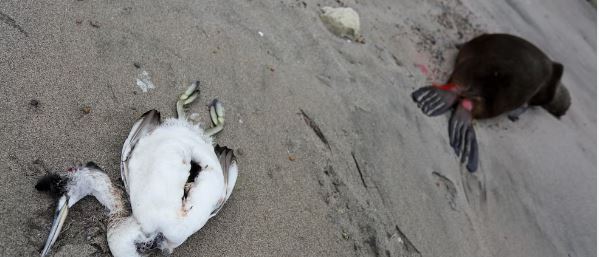
June 16: In the last two years, bird flu has been blamed for the deaths of millions of wild and domestic birds worldwide. It's killed legions of seals and sea lions, wiped out mink farms, and dispatched cats, dogs, skunks, foxes and even a polar bear.
But it seems to have hardly touched people.
That's "a little bit of a head scratcher,” although there are some likely explanations, said Richard Webby, a flu researcher at St. Jude Children’s Research Hospital in Memphis, Tennessee. It could have to do with how infection occurs or because species have differences in the microscopic docking points that flu viruses need to take root and multiply in cells, experts say.
But what keeps scientists awake at night is whether that situation will change.
“There's a lot we don't understand,” said Dr. Tom Frieden, a former CDC director who currently heads Resolve to Save Lives, a not-for-profit that works to prevent epidemics. “I think we have to get over the 'hope for the best and bury our head in the sand' approach. Because it could be really bad."
Some researchers theorize that flu viruses that originated in birds were the precursors to terrible scourges in humans, including pandemics in 1918 and 1957. Those viruses became deadly human contagions and spread in animals and people.
A number of experts think it’s unlikely this virus will become a deadly global contagion, based on current evidence. But that's not a sure bet.
Just in case, U.S. health officials are readying vaccines and making other preparations. But they are holding off on bolder steps because the virus isn't causing severe disease in people and they have no strong evidence it’s spreading from person to person.
The flu that's currently spreading — known as H5N1 — was first identified in birds in 1959. It didn’t really begin to worry health officials until a Hong Kong outbreak in 1997 that involved severe human illnesses and deaths.
It has caused hundreds of deaths around the world, the vast majority of them involving direct contact between people and infected birds. When there was apparent spread between people, it involved very close and extended contact within households.
Like other viruses, however, the H5N1 virus has mutated over time. In the last few years, one particular strain has spread alarmingly quickly and widely.
In the United States, animal outbreaks have been reported at dozens of dairy cow farms and more than 1,000 poultry flocks, according to the U.S. Department of Agriculture. Four human infections have been reported among the hundreds of thousands of people who work at U.S. poultry and dairy farms, though that may be an undercount.
Worldwide, doctors have detected 15 human infections caused by the widely circulating bird flu strain. The count includes one death — a 38-year-old woman in southern China in 2022 — but most people had either no symptoms or only mild ones, according to the U.S. Centers for Disease Control and Prevention.
There's no way to know how many animals have been infected, but certain creatures seem to be getting more severe illnesses.
Take cats, for example. Flu is commonly thought of as a disease of the lungs, but the virus can attack and multiply in other parts of the body too. In cats, scientists have found the virus attacking the brain, damaging and clotting blood vessels and causing seizures and death. (AP)












